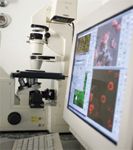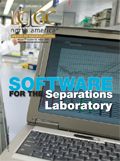Evolving Chromatography Software: Using Standards to Create an Analytical Software Ecosystem
Special Issues
Common systems for instrument control, data acquisition, and analysis would enhance the productivity of most laboratories greatly.
Managers of chromatography laboratories have systems from multiple vendors, each with its own proprietary informatics system for instrument control and data analysis. Software from one vendor can often control instruments from another, sometimes with the added frustration that not all of the instrument's capabilities are accessible. Laboratory staff must be trained to use all of these systems. They often find their efforts to generate and manage data stymied by having to interact with and analyze data from a multitude of incompatible chromatography systems, thus, hampering productive decision making. Regulatory requirements for data archiving and retrieval often require the retention of obsolete software that staff must continue to be trained on. In addition, the information management team must support multiple software systems and somehow find a way to store all of the information in a way that allows rapid data retrieval and comparison, as well as long-term data archiving. All of these obstacles can make a "paperless laboratory" a wistful fantasy.

(Photo: Getty Images)
Towards Open Standards
Traditionally, chromatography system suppliers have developed a bilateral relationship to share or exchange control code documentation for their instruments, and software developers for the two companies write software to control the instrument based upon the documentation supplied. Using this model, the original supplier of the chromatography instrumentation writes a driver for their software, then company A will write another driver, company B will write another driver, company C will write another driver, and suddenly there are four drivers written by different companies, each one a little bit different, but doing basically the same thing. This process of "reinventing the wheel" over and over again requires time, money, and human resources, and in the end, the customer suffers because of delays in availability and inconsistent functionality of the drivers.
Alternatively, using an open standards approach, the instrument manufacturer writes a driver that, because of its compliance with standard interfaces, plugs into the software of other manufacturers' chromatography systems in a fairly straightforward way. While this might seem like a lofty goal that will take a long time to be implemented, technical proof of concept has started between some of the chromatography system manufacturers. With this new model, the instrument vendor writes the driver, and the customer gets that driver quickly and with the complete functionality of the instrument, independent of the software platform that they are using.
Standardization Beyond Instrument Control
Instrument control is not the only area where we have seen improved collaboration between vendors. It was announced recently that the OpenLAB Enterprise Content Manager (ECM) (Agilent, Santa Clara, California) now interfaces with the Chromeleon chromatography data system (CDS) (Dionex, Sunnyvale, California). While the Chromeleon user interface certainly offers the best way to view data generated by the system, laboratories that need a central repository for all their data are best served with one common user interface to access data generated by different software packages.
Software such as OpenLAB ECM, mentioned above, acts as a central repository for chromatography information regardless of its source and format, and allows retrieval of that information even if the software that originally generated it is obsolete (Figure 1). Retrieving information which is stored in by the system is made possible with the use of filters designed specifically for each data system. These filters extract key attributes from the original data that are then used for searching. In addition, it provides the ability to create, capture, manage, collaborate and re-use information from many suppliers, including reports, spreadsheets, Word documents, PDF files, HTML files, e-mail, and more. A Web-based user interface reduces the learning curve for new users and allows universal access.

Figure 1: OpenLAB ECM web-based user interface.
To meet the requirements of open standards, a "technology-neutral format" (TNF) has been developed, based upon the emerging IUPAC and ASTM standard, ANiML — analytical information markup language. ANiML is a data interchange standard based upon XML that leverages advances in platform-independent data representation and combines the experience of these organizations in describing measurements, instruments, and physical properties. A TNF provides the valuable capability to retire and store data for as long as required by regulatory bodies (Figure 2). Developing technology-neutral files requires a comprehensive understanding of the original data format and results. This information is obtained in one of two ways: through vendor collaboration or commercially available software development kits (SDKs). Key to TNF development is access to information to help build the ecosystem, where no one vendor supplies everything.

Figure 2: Chromatography data converted to a "technology-neutral format" and viewable with OpenLAB TNF Viewer.
Adoption of Enterprise Content Management
Many companies are developing enterprise-wide electronic information systems that leverage the advantages of systems such as those mentioned above and TNFs. For example, a large multinational pharmaceutical has integrated OpenLAB ECM into its laboratory data acquisition system, which provides fast and secure access to quality data, increases compliance, and decreases maintenance costs. In this context, the system manages raw data and human readable documents of any file type, including the Waters Empower CDS files (Waters, Milford, Massachusetts). In addition, it provides metadata extraction from analytical and word processing applications via application specific filters. The system also is fully scalable to respond to the growing need for such information at the company, and it enables compliance with all major regulatory guidelines, including 21 CFR part 11. The system has enabled the archival of more than a million raw data files with hundreds of users, providing terabytes of archived data. In addition, the integrated Business Process Manager module has provided automation of mission-critical business processes in a secure environment (Figure 3).

Figure 3: OpenLAB Business Process Manager provides tools to streamline processes (routing for electronic signatures, email alerts) in the laboratory using the familiar Microsoft Visio.
Another top 10 pharmaceutical company has used the TNF capability to implement a solution for making legacy data accessible. This company needs to retain access to such data for longer than 30 years to satisfy regulatory and intellectual property requirements, and to maximize the long-term research value of acquired data. They began the project with CDSs that were obsolete but held important development information. To maintain access to this data without the need to maintain or train users on these obsolete software platforms, they implemented the system with technology-neutral format capabilities to retain data across vendor platforms for chromatography. One key to success for this program was the implementation of sensible record retention and destruction policies that provided for routine purging of unnecessary information in an orderly and regular manner. In the future, the company sees a need for vendor-independent processing or viewing of analytical instrument data, thus, reinforcing the importance of open standards.
What the Future Holds
The open standards initiative holds out the promise of universal access to multivendor instrument control, providing all laboratories with the capability to use one software platform, rather than having to train and maintain multiple platforms. One concept that could make this idea a reality is that of replacing current instrument driver technology with a "printer driver" approach using Microsoft .NET technology. This concept would eliminate the need for any vendor to write multiple drivers to interface their software with that of other vendors.
These "printer" drivers would by necessity use a common language to communicate parameters such as flow rates, wave lengths, solvent gradients, and so forth, so that instrument methods could be used interchangeably across CDSs regardless of vendor. This common dictionary of terms would be a product of the open standards initiative and would be contained in a standard programming language like ANiML. Such standardization would benefit both chromatography users and vendors, because users could interface a multitude of software modules, and vendors could all write their software to one standard.
One end result of such standardization efforts could be a broad range of powerful collaboration tools embedded in the software platform, giving the ability to share data and its analysis throughout a worldwide organization via discussion forums, RSS feeds, visualization tools, and social networking tools such as blogs and wikis. Global identity management could provide access to all authorized users across the organization, anywhere and anytime.
Conclusion
A common set of open standards for chromatography software is clearly needed to eliminate the frustration and extra effort experienced by both users and chromatography system vendors, due to the lack of common systems.
The proprietary system discussed here is an example for what future systems can do to create, manage, collaborate, archive, and reuse business-critical information with ease. With an open systems approach to instrument control and data management, this system provides the beginning of a new software "ecosystem." Using this mainstream approach to software development, all users and vendors have the ability to collaborate and no one instrument company has to provide all the capabilities that a customer might need to fulfill their mission. This open systems environment will provide users with the optimal ability to turn data into information, information into knowledge, and knowledge into insightful, long-term wisdom.
Linda Doherty
Agilent Technologies
Please direct correspondence to linda_doherty@agilent.com

What Goes in a CDS IT Service Level Agreement?
Published: April 7th 2025 | Updated: April 7th 2025Protecting your network chromatography data system (CDS) data is critical and a service level agreement (SLA) with your IT provider is vital. What should be included? Are SLAs for in-house IT and SaaS (software as a service) similar?
Advanced LC–MS Analysis for PFAS Analysis in Eggs
October 11th 2024The European Commission's regulation on maximum levels for certain contaminants in food highlights the need for precise and reliable methods to quantify per- and polyfluoroalkyl substances (PFAS) in various food matrices. This article discusses development and validation of a robust method for analyzing 21 PFAS compounds in chicken eggs using solid-phase extraction (SPE) and liquid chromatography–mass spectrometry (LC–MS).








